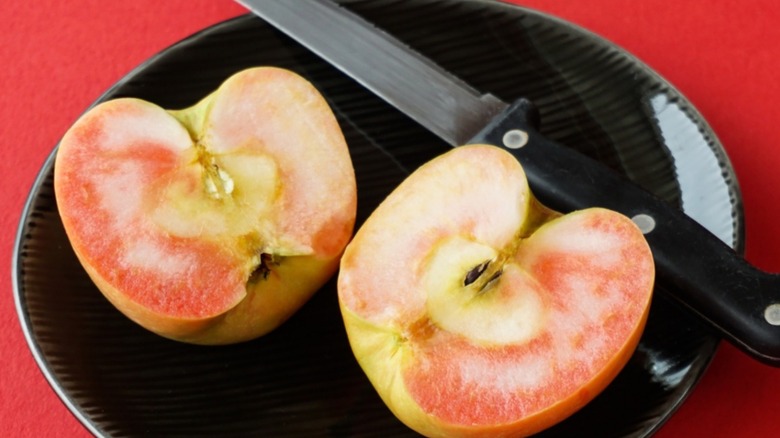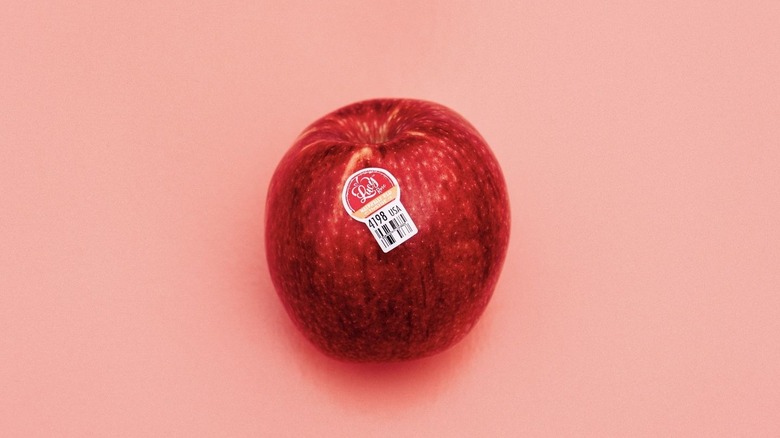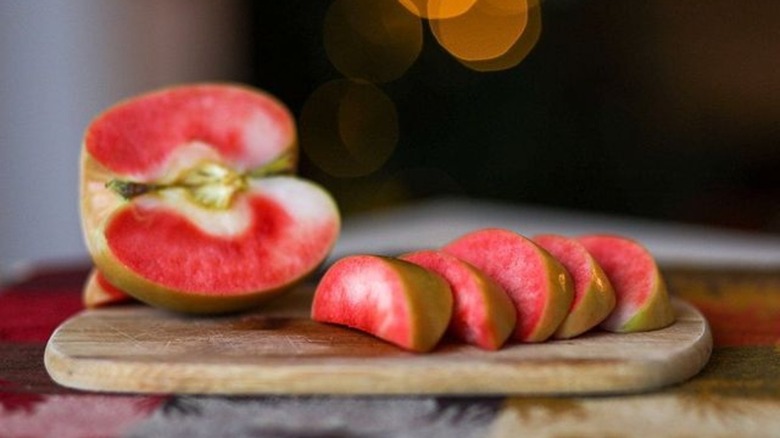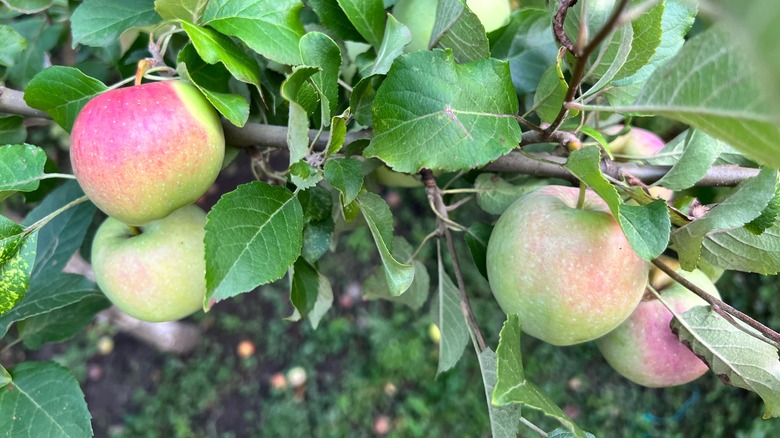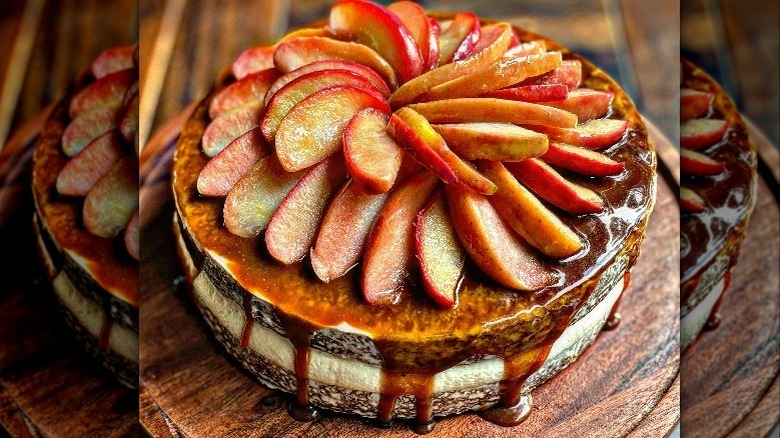What Is A Lucy Apple And What Does It Taste Like?
Red Delicious, Granny Smith, Honeycrisp, Jazz, and Gala — a handful of the many varieties of the apple. Whether you're baking them into a pie, stuffing them into pancakes, or just eating them with peanut butter, there's a wide list of ways to cook using apples. But similar to how different types of wine are sought out for reasons like flavor notes and aroma, some apples are prized for being the sweetest or tartest, and some have the crispest texture, and so on.
If you're baking up an all-American apple pie, it's recommended you go for an apple that has that classic sweet and tart profile, such as a Braeburn or Granny Smith (via The Pioneer Woman). If you're making an apple crisp, you'll want apples that won't turn to sticky mush if you put them in the oven, so the crispness of the Jonagold or the aptly-named Crispin will do well (via Southern Living).
But for all the talk about different types of apples, there's one type of apple that's relatively "new" and carefully bred to combine sweetness, tartness, and an explosion of color that sets it apart from the rest. It's called the Lucy Apple and it comes in not one, but two, striking varieties.
The story behind a Lucy Apple
According to the fruit company and grower of the Lucy Apple, Chelan Fresh, this unique hybrid is a cross between the delicious Honeycrisp apple and the colorful Airlie Red apple. Lucy's origins are credited to Bill Howell, an "apple breeder" and former research technologist in plant virology (via Capital Press). According to Howell, he was inspired by seeing red-fleshed apples, an uncommon variety of apples whose interior is colored a shade of red rather than the usual pale-yellow color. While red-fleshed apples are indeed an attractive shade of red, the high amounts of anthocyanins, pigments that give fruits and vegetables certain colors such as red, blue, or purple, have the tendency to give the fruits a surprisingly bitter taste (via Salon). What Bill Howell wanted was to create a red-fleshed apple that was both attractive to look at and pleasant to eat.
To create the perfect rosy red fruit, Howell carefully pollinated red-fleshed apple seeds alongside the more common Honeycrisp apples in his orchard. Taking only the best seeds of this natural pollination process, Howell's long and laborious work paid off. Not one, but two varieties of red-fleshed apples came to be: The Lucy Glo and the Lucy Rose.
What do Lucy Apples taste like?
Lucy Apples, the official website named after the fruit, describes the Lucy Rose as having a bright red exterior similar to a Red Delicious apple and having a flavorful profile with berry undertones. The Lucy Glo, in comparison, has a light golden-red exterior and a particularly tangy, sweet flavor.
If there is any discrepancy on what Lucy Apples actually taste like, it would likely be due to a person's unique palate. One YouTuber reviews the Lucy Rose and says she "apple-solutely loves it," states that it tastes like berries, and describes it as an "amazing eating experience." Another YouTuber reviews the Lucy Glo and offers a truly glowing review, with an "eight out of 10" rating.
Eat Like No One Else also reviewed the Lucy Rose, complimenting it for not only the attractive red interior but also for having the crispness of a traditional Honeycrisp apple. The review did note that it wasn't as crisp or juicy as the Honeycrisp due to the apple's red-fleshed parentage, but the flavor was more concentrated and did indeed have hints of berries. Adam's Apples reviewed the Lucy Glo, noting that while it was too sweet for his taste, it still had a pleasant tartness and strong berry tones to it that would make it perfect for fans of the Honeycrisp or other sweet apple variety.
Where can I buy a Lucy Apple?
While you can easily take a trip to your local grocer or farmer's market and get some Gala apples or Cosmic Crisps, getting your hands on any variety of Lucy Apple is a bit more complicated. Chelan Fresh, the growers of the Lucy Apple, explain that they are only available for a relatively short window of time from October to February. According to The Packer, Lucy Apples were for sale last season starting in the fall of 2021, with only 25,000 boxes available.
If these apples were in stock, you would use the handy Lucy Fruit Locator to find the closest store that carries them. While helpful, it's best to remember that due to a small amount of Lucy Apples being grown per season, they are only available in and around the West Coast area. But there's no need to worry if you live across the state. You can go on Goldbelly and order a box of 12 Lucy Glo Apples for about $70 dollars — when they are in season, of course.
What are the benefits of choosing Lucy Apples?
You would be forgiven for believing an apple with red flesh was a sign of a superfood or an apple of particularly healthy benefits. The truth is that red-fleshed apples may actually be healthier than more conventional apples. Remember those anthocyanin pigments mentioned earlier? There are studies being conducted in order to see if a high level of anthocyanins might offer a large amount of antioxidants (via Plant and Food Research).
The Lucy Apple contains approximately 95 calories, 3 grams of fiber, and several flavonoids that act as anti-inflammatories and might also boost heart and blood health (via Specialty Produce). It's important to remember that all apples, no matter what flesh color they are, have a wide variety of health benefits from supporting weight loss to boosting the immune system (via Everyday Health).
Aside from health benefits, what exactly can you do with Lucy Apples? This particular variety is suggested for baking into an easy apple pie, but Chelan Fresh suggests baking them in a honey-cinnamon mixture and using them in a cake with goat cheese and caramel sauce. And if you're wondering, both varieties are perfect for eating raw as a quick snack, just like any other crisp and juicy apple.
